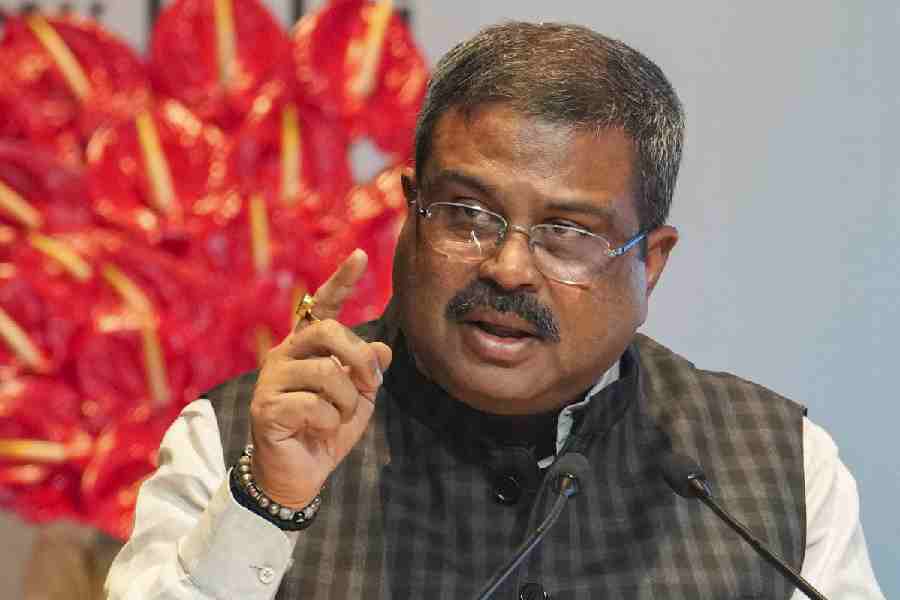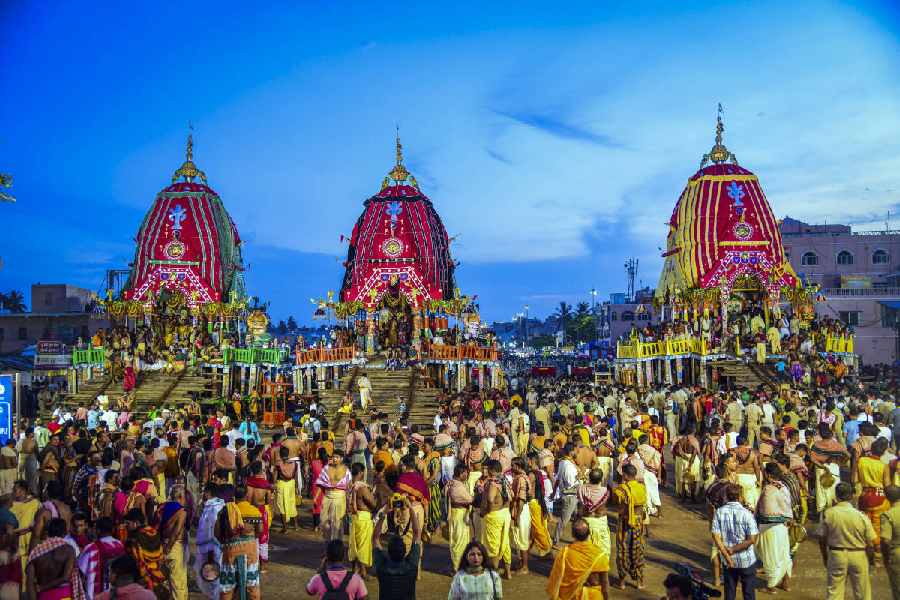 |
| Aishwarya Rai on the sets of Chokher Bali. Picture by Aranya Sen |
Aishwarya Rai on the sets of Chokher Bali. Picture by Aranya SenLew Hilt (centre) and Subhen Chatterjee with Sivamani
A brief ode to beauty — Aishwarya Rai drifts into a stuffy Tollygunge studio; black shawl draped over a cream sari with black border, no trace of make-up, long hair tied back enhancing the vulnerability in Binodini’s limpid brown eyes.
The nation’s reigning beauty queen — she doesn’t like being called that (“I know it’s inevitable since the Miss World days, but even then I would see myself as an Indian ambassador on a world platform, rather than just a model or beauty queen”) – is happy to be back in Bengal.
“I have never believed in the concept of boundaries in cinema or definitions in life,” is how she explains what she is doing here (on a rickety red plastic chair this sweltering March afternoon in Tollywood) and now (that she is Bollywood’s numero uno and can command project and price).
“I consider myself to be a student of cinema seeking projects that can contribute to my growth as an actor,” she says, putting away a strand of hair blowing in the whirring-fan wind with a kind of casual deliberation. “And what could be a better combination than Tagore’s story (Chokher Bali), Ritu’s film (Rituparno Ghosh having taken exactly what he wants from the classic) and Binodini’s character?”
Through these three schedules (Bengal, Benares and Bengal), she has “evolved surely and steadily into Binodini”, observes Rituparno. And in doing so, the maiden from today’s Mumbai seems to have developed a strange bond with the wilful widow from yesterday’s Bengal. “She is fascinating, multi-faceted, paradoxical, so intriguing, that it’s an enriching experience discovering her.”
And in discovering Binodini, who refused to live by the rules in her world, her times, the actress, slender yet strong, wilful yet vulnerable, seems to be discovering bits that make up who she is — along with a bit of Nandini in Hum Dil De Chuke Sanam, Maanvi in Taal, Megha in Mohabbatein and Paro in Devdas, and, of course, a girl they all call Ash. “I truly believe that life should have no definitions. Just discover, so that you have a story to live and to tell…”
Clearly, the journey from Bandra to Bengal — defying all industry logic — has been a step in the right direction for someone striving to “discover the actor in me and be truly versatile”. The quest to experiment and in the magic of cinema immerse, started early, when Mani Ratnam happened. “That was the first real justification of my decision to be an actress and not go abroad to pursue architecture… I guess I’ve now become the architect of other dreams,” smiles Aishwarya.
An architect of dreams spun out on celluloid, of fantasies in reality-bite times. “I call myself ‘mazdoor janta’, slogging 25 hours a day, with hardly any day off. But I enjoy being busy and don’t think of my work or what comes with it as a strain. I just want to Be, anything else would be such an effort.”
Her bid to ‘be’ extends from “pigging out” on mishti doi and nalen gurer sandesh (“because I am a foodie with a big-time sweet tooth”) to “being involved in every aspect of a film (“as I am bitten by the creative bug and love speaking my mind”); keeping a ‘safety net’ of friends who do not demand time or attention and a normal family (“dad, mom and bro”) firmly in place, to still being hesitant about how to react to a compliment (“Of course, I am awkward when someone calls me beautiful”).
That’s inside. Where she keeps drifting into spaces that are hers, and hers alone. Where there’s more than a hint of melancholy.
Outside, she is the cause for thousands of men and women to drop everything and wait for hours on College Street, no less, chanting “Paro, Paro….”
Ever since he made waves with the promising Eden Of Joy, a bunch of original songs dedicated to Mother Teresa and children afflicted with thalaessemia, singer-lyricist Joy Bhaduri has waded from one project to another with effortless ease, fusing music, compassion and spirituality with elan. Now he is ready to roll out his new project, Bluestock, the art podium and rhythm and blues band.
Formed in January this year, Bluestock will do its maiden concert at Gyan Manch on March 15. The brainchild of “free-lance expressionist” Joy, who has been working through the mixed mediums of painting, music, poetry, photography and philosophy, Bluestock will cater to different forms of music and alternative arts.
‘A Blues Musical Evening’, showcased as “a spiritual ode to the human kind with a vision-free quest for peace”, will feature, apart from Joy, Nondon Bagchi on drums and Sougata Roy Chowdhury on sarod as guest artistes. Bluestock is: Bua on guitars, Pom on drums, Pupu on bass, Bhutto on keyboard and Joy himself with the vocals and lyrics.
Part I of the band’s maiden gig is titled Uni-versed in Blue, and will feature Kaivalyam (a guitar ode), In-Deed (a spiritual vocal recital), Dharinee (an ode to Mother Teresa) on sarod by Sougata, Blue Life Lines (guitar and verses) and The Soul Barkars.
Part II has Blue-Sticks by Nondon and BlueStock – The First Phase, while Part III, A Bandwaggin’ Jam, has a set of five tracks —Kaal-Yog, In-Quest, Wake Up, Meaning and Amusing The Time.
‘Blue’ as a core relating living expression for Joy, the artist, is — ‘Beholding Life’s United Essence’. He had been associated with Mother Teresa for seven years, and has been working as psychological counsellor and art therapist among drug victims, slums and backyard shanties. Following his work with the bauls of Birbhum, and Bongaon, Joy wrote his first project for an Ohio-based record label, Living Records, for a two-part CD, The Soul Barkars.
“Bluestock will focus on original scores in concerts, besides some old tributes to masters of rhythm and blues,” explains Joy.
 |
| Lew Hilt (centre) and Subhen Chatterjee with Sivamani |
Karma, which kicked off the fusion movement in Calcutta way back in 1986, and remains one of the most accomplished bands in business, celebrates its 17th anniversary next week with a troika of gigs. The inaugural concert is at Swabhumi on March 14, followed by Saturday Club the next evening and Calcutta Rowing Club on March 17.
“There are a lot of surprises in store for the fans who have been with us through the years,” says Subhen Chatterjee. He, along with veteran bassist Lew Hilt, still forms the backbone of the band which also comprises Dev Shankar (violin), Raghav (vocals), Moloy (drums), Anjan (lead guitar) and Bumpy (keyboards). Six new compositions are being readied for the birthday bash, which will have free-form interactive platforms to include “well-wishers” among the city’s musical fraternity.
A magician sprinkles some mystery powder into the cauldron and out swirls a python. Waving its head, it flings itself among the audience, spewing venom as people shut their eyes and duck in fear. Next to follow are a human skull hanging in mid-air and scores of rats leaping out at the wave of the magician’s wand.
All such experiences are as life-like as it gets at Nicco Park’s 3-D theatre. Inaugurated last week, the show is Calcutta’s oldest amusement park’s newest attraction. Two shows are being offered at the 36-seater hall, over a thrilltime of about 15 minutes.
The Rs 25-lakh show has been acquired from Microcel, a New York-based techno-entertainment company, says vice-president, operations & projects, Abhijeet Dutta.
The park is also gearing up to roll out the tracks for the city’s biggest roller-coaster. The ropeway, which will rise to over 50 feet, will have seven dips and lifts. Construction is in the final stages after months of round-the-clock work at the one-acre site.
“We are looking at a March-end deadline,” Dutta adds.










